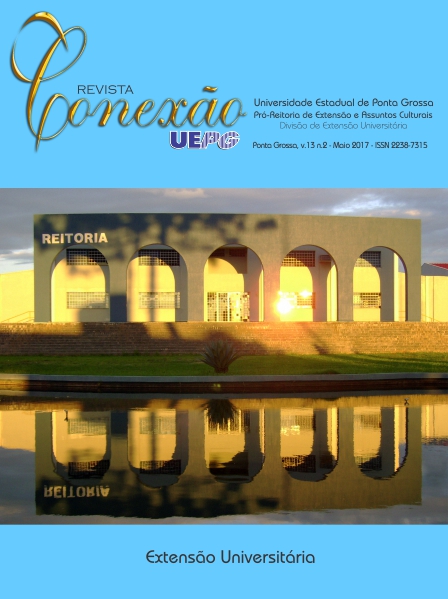“IF YOU LOVE YOURSELF, YOU WILL PROTECT YOUR SKIN FROM SUN DAMAGE”: PHARMACEUTICAL GUIDANCE IN THE FIGHT AGAINST SKIN CANCER
DOI:
https://doi.org/10.5212/Rev.Conexao.v.13.i2.0008Keywords:
sunscreening agents, skin neoplasms, health education, health promotion, healthy behavior.Abstract
This study aimed at characterizing the participants and showing the educational materials of a university extension activity on photoprotection [A1]. The campaign was devised by Brazil’s National Forum of Teaching Pharmacies (FNFU) and involves several universities throughout the country. Questionnaires on the regular use of photoprotective products by students enrolled in various undergraduate courses, university employees and outsourced workers were handed to all the people who visited the site of the campaign “If you love yourself, you will protect your skin from sun damage: pharmaceutical guidance in the fight against skin cancer”. Out of the 235 respondents, 40.85% reported using photoprotective products on a daily basis, and the reasons given by most of those who did not do it were forgetfulness, lack of time and the high cost of these products. Therefore, the study collected important information on the use of sunscreen and on the level of information of the academic community about this issue.
Downloads
References
ALVES, P. M; SANTOS, V.C; CARDOSO, D. O. Radiação ultravioleta residual de lâmpadas fluorescentes no tratamento da hiperbilirrubinemia neonatal. Rev. Militar de Ciência e Tecnologia, Rio de Janeiro, v. 25, p. 35-44, 2008.
BAKOS, L. et al. Estudo comparativo sobre o conhecimento e comportamento de adolescentes e adultos frente à exposição solar. An. Bras. Dermatol. Rio de Janeiro, v. 72, n. 3, p. 241-245, 1997.
BRAGA, L. S. Uso de protetor solar e deficiência de vitamina D na infância e adolescência: uma revisão sistemática. Trabalho (Conclusão de Curso Graduação) – Curso médico da Faculdade de Medicina Bahia, Universidade Federal da Bahia, Salvador, 2014.
BROETTO, J. et al. Tratamento cirúrgico dos carcinomas basocelular e espinocelular: experiência dos Serviços de Cirurgia Plástica do Hospital Ipiranga. Rev Bras Cir Plást., São Paulo, v. 27, n. 4, p. 527-30, 2012.
CAPOBIANCO, L. Comunicação e Literacia Digital na Internet – Estudo etnográfico e análise exploratória de dados do Programa de Inclusão Digital AcessaSP – PONLINE. Dissertação (Mestrado em Ciências da Comunicação) – Escola de Comunicação e Artes, Universidade de São Paulo, 2010.
CASTRO, I. A. Expressão da proteína p53 em diferentes níveis de fotoenvelhecimento da pele. Dissertação (Mestrado) – Faculdade de Ciências Médicas, Universidade Federal do Rio Grande do Sul, Porto Alegre, 2007.
COSTA, F. B.; WEBER, M. B. Avaliação dos hábitos de exposição ao sol e de fotoproteção dos universitários da Região Metropolitana de Porto Alegre, RS. An. Bras. Dermatol., Rio de Janeiro, v. 79, n. 2, p. 149-55, mar. 2004.
DIDIER, F. B.; BRUM, L. F.; AERTS, D. R. Hábitos de exposição ao sol e uso de fotoproteção entre estudantes universitários de Teresina, Piauí. Epidemiologia e Serviços de Saúde, Brasília, v. 23, n. 3, p.487-496, set. 2014.
FERNANDES, L. Redes sociais online e educação: contributo do Facebook no contexto das comunidades virtuais de aprendentes. Lisboa: Universidade de Nova Lisboa. Disponível em: < http://www.trmef.lfernandes.info/ensaio_TRMEF.pdf> Acesso em: 14 mar. 2017.
GAZZINELLI, M. F.; REIS, D. C.; MARQUES, R. C. Educação em saúde: teoria, método e imaginação. Belo Horizonte: Ed UFMG, 2006. 166 p.
INSTITUTO NACIONAL DO CÂNCER – INCA. Tipos de câncer: pele não melanoma. Disponível em: <http://www2.inca.gov.br/wps/wcm/connect/tiposdecancer/site/home/pele_nao_melanoma>. Acesso em: 15 abr. 2016.
INSTITUTO ONCOGUIA. Câncer de Pele Basocelular e Espinocelular. Disponível em: <http://www.oncoguia.org.br/conteudo/sobre-o-cancer/751/146/15>. Acesso em: 15 abr. 2016.
KUHL, I. C. P. Fotoproteção na adolescência. An. Bras. Dermatol., Rio de Janeiro, v. 73, n. 38, 1998.
PICANÇO, A. C. et al. Conhecimentos, atitudes e práticas dos acadêmicos de fisioterapia acerca da fotoproteção em atendimentos nas comunidades. Ter. Man, São Paulo, v.9, n.45, p. 465-469, 2011.
POPIM, R. C. et al. Câncer de pele: uso de medidas preventivas e perfil demográfico de um grupo de risco na cidade de Botucatu. Rev. Ciência & Saúde Coletiva, v.13, n.4, p.1331-1336, 2008.
SILVA, A. L. A. et al. A importância do uso de protetores solares na prevenção do fotoenvelhecimento e câncer de pele. Rev. Interfaces: Saúde, Humanas e Tecnologia, Juazeiro do Norte, v.3, n. 1, p. 2-8, 2015.
SILVA, C.V. et al. Campanha de fotoeducação: orientações à população de Salvador-BA por estudantes de farmácia. Rev. UFG, Goiânia, v.15, n. 16, p. 77-89, 2015.
SIQUEIRA, C.G. et al. Núcleo de Atenção Farmacêutica da UNIFAL-MG (NAFAU). Rev. Universidade Vale do Rio Verde, Três Corações, v. 14, n. 2, p. 1079-1083, 2016.
SOCIEDADE BRASILEIRA DE DERMATOLOGIA. Câncer da pele. Disponível em: <http://www.sbd.org.br/doencas/cancer-da-pele/>. Acesso em: 15 abr. 2016.
UFG. UNIVERSIDADE FEDERAL DE GOIÁS. Campanha Fotoeducação: Proteja a sua pele. Disponível em:<https://m.facebook.com/profile.php?v=timeline&timecutoff=1385554168§ionLoadingID=m_timeline_loading_div_1357027199_1325404800_8_&timeend=1357027199×tart=1325404800&tm=AQAwxhkvui4b-m__&id=466101213412511 >Acesso em: 18 set. 2016.
UFPI. UNIVERSIDADE FEDERAL DO PIAUÍ. Campanha Fotoeducação: Quem se ama, protege sua pele. Disponível em: <http://www.ufpi.br/noticia.php?id=25100> Acesso em: 18 set. 2016.
URSAKI, M. B. M. et al. Exposure and Sun protection practices of university students. Rev Bras Enferm. São Paulo, v. 69, n. 1, p. 114-21. 2016. Disponível em: <http://dx.doi.org/10.1590/0034-7167.2016690117i>. Acesso em: 18 fev. 2017.
Downloads
Published
Issue
Section
License
a) Authors retain copyright and grant the journal right of first publication with the work simultaneously licensed under a Creative Commons Attribution License that allows others to share the work with an acknowledgement of the work's authorship and initial publication in this journal.
b) By submitting an article to the Revista Conexão UEPG and having it approved, the authors agree to assign, without compensation, the following rights to the Journal: the rights of first publication and the rights to redistribute the article and its metadata to the indexing and reference services that the editors deem appropriate.
c) Readers are free to transfer, print out and use the articles published in the Journal, as long as there is always explicit mention to the author(s) and to the Revista Conexão UEPG and as long as there is no alteration of the original work. Any other use of the texts needs to be approved by the author(s) and by the Journal.






